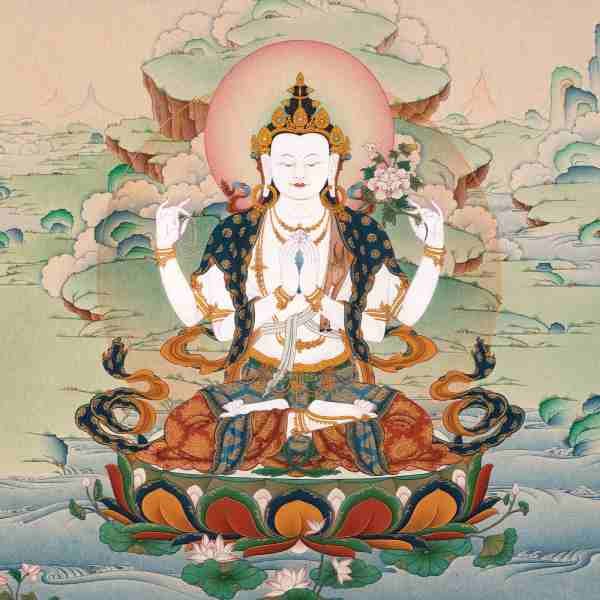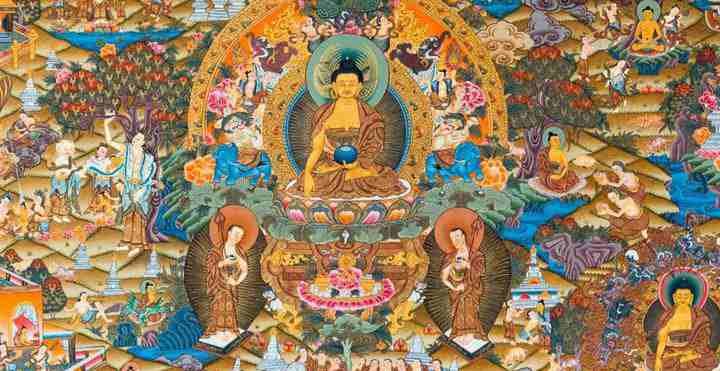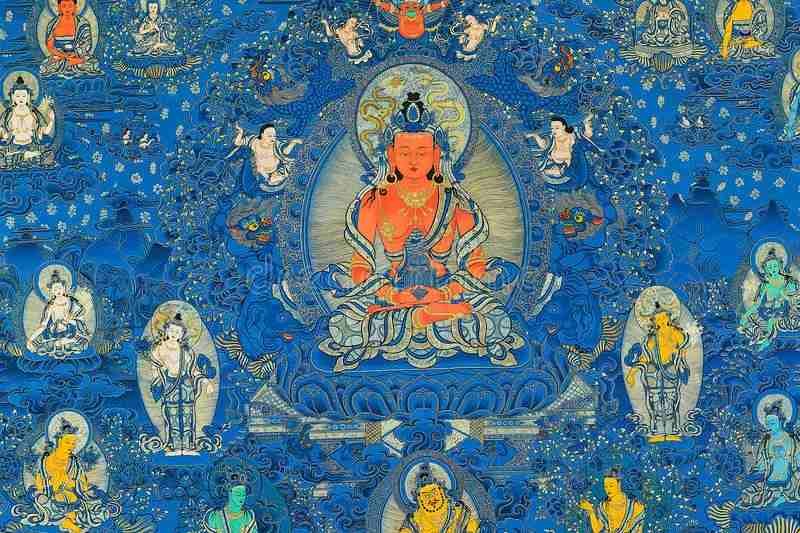What is Thangka art?
This art is a traditional Tibetan scroll painting created on cotton or silk canvas. It dates back to the 7th century. These paintings commonly depict Buddhist deities. They also depict mandalas and scenes from religious scriptures. A standard painting measures around 75×50 cm. Some can be much larger depending on their purpose.
Each piece of art is precisely painted. It follows strict iconographic guidelines designed by Buddhist teachings. The colors are derived from natural pigments like crushed minerals and plants. It ensures the vibrancy lasting centuries. Gold is used in finer pieces of art to highlight important elements. It reflects the divine light of the depicted subject.
These paintings are not just purely artistic. They serve as tools for meditation, teaching, and rituals. A mandala represents the cosmos. It aims for practitioners to focus during meditation. Their portability made them invaluable for traveling monks. These monks needed visual aids to convey complex teachings.
Today, this art form is recognized as an important cultural artifact. Scholars and spiritual practitioners are drawn to the rich history and spiritual significance. It continues to thrive in Tibet, Nepal, and Bhutan.
What is the origin of Thangka paintings?
This art form originated in Tibet during the 7th century. It is linked to the spread of Buddhism under King Songtsen Gampo. Early pieces of art were inspired by Indian and Nepalese artistic traditions. The Pata scrolls of India and Paubha paintings of Nepal were included.
The rise of Tibetan monasteries in the 11th century marked a significant development in this art. Monasteries began commissioning this art for use in rituals and meditation practices. This art form became a formalized practice with established schools such as the Menri (Nepalese-influenced) and Karma Gadri styles.
The creation of these paintings is highly symbolic. Artists follow proportions outlined in Buddhist texts (Lama Sangwa Duepa) ensuring accuracy in every detail. A completed piece of art often receives a consecration ceremony by a Lama. That transforms it from a mere painting into a sacred object.
Today, this style of painting is taught in formal art schools in Tibet and Nepal. Its origins and evolution reflect the cultural exchanges between Tibet, India, and Nepal. This makes it a cornerstone of Himalayan Buddhist art.
What is Thangka’s role in spiritual practices and meditation?
This artwork plays a critical role in Tibetan Buddhism. It serves as a visual guide for meditation practices. Meditators use them to concentrate their minds on specific teachings or deities. This enhances their focus and understanding.
One of the most commonly used ones in meditation is the Mandala. It represents the Buddhist concept of the universe. Mandalas are used in visualization techniques. Practitioners imagine themselves entering the sacred space depicted in the painting.

Deity Thangka referred to as Avalokiteshvara (the Bodhisattva of Compassion) is used for devotional practices. Practitioners focus on these deities to cultivate qualities like compassion and wisdom.
Monks chant mantras as when offer prayers. They also perform ceremonies in front of these sacred paintings. The Kalachakra is central to the Kalachakra initiation. It is a complex ritual involving thousands of participants.
Modern research highlights the meditative benefits of using visual aids like a piece of this art form. Neuroscientific studies indicate that sustained visual focus during meditation can reduce stress and improve mental clarity. Hence this art form is relevant to contemporary mindfulness practices.
Understanding the Art form
What symbols are used in Thangka paintings?
The paintings are loaded with complex symbols. Each symbol is carefully crafted to convey spiritual significance and Buddhist teachings. The Eight Auspicious Symbols are among the most prominent. These include the parasol which symbolizes protection from suffering. The golden fish represents happiness and freedom. The conch shell represents the spread of Buddhist teachings. The endless knot reflects the interconnectedness of all existence. Other symbols include the lotus flower which represents purity and enlightenment. The wheel of dharma signifies the Buddha’s teachings.
Mandalas are another significant element. These geometric patterns represent the universe and are used for meditation. Their concentric circles and squares guide practitioners toward spiritual awakening. Colors also carry meaning. Gold symbolizes enlightenment. Red conveys transformation. Blue represents wisdom.

Buddhist deities and Bodhisattvas are the main focus of this art form. Avalokiteshvara’s figure with multiple arms symbolizes boundless compassion. Avalokiteshvara seated on a lotus depicts virtues. Each deity’s posture, mudra (hand gesture), and accompanying objects like vajras (thunderbolts) or jewels have deep spiritual meaning.
Every detail in each piece of art adheres to precise iconographic rules. It ensures that the painting functions as both a spiritual tool and a sacred text.
How do art elements reflect Buddhist teachings and philosophies?
Each element reflects core Buddhist teachings. It serves as a visual representation of the path to enlightenment. The central figures are deities or Bodhisattvas. They embody values and morality. White Tara symbolizes longevity and compassion. Yamantaka represents the conquest of ignorance and death. The attributes like lotus flowers (purity) or vajras (spiritual power ) reinforce these virtues.
Mandalas in this art form represent Buddhist cosmology. The outer circle symbolizes the material world. The inner layers guide the practitioner to enlightenment. Mandalas emphasizes the impermanence of life and the interconnectedness of all beings. Practitioners meditate on mandalas to visualize their spiritual journey.

The art frequently depicts natural elements like mountains, rivers, and the sun. Mountains symbolize strength. Rivers symbolize the flow of life and spiritual wisdom. The rising sun represents the dawn of enlightenment. Colors are equally symbolic. White denotes purity. Green represents balance and yellow represents abundance.
By blending these elements, it functions as more than art. These paintings are spiritual maps that guide viewers toward understanding Buddhist principles.
Meditation Aid
Scientific studies have shown that focusing on complex images can significantly reduce stress. Monks use these paintings for extended meditation sessions in Tibetan monasteries. This art form seamlessly integrates art with profound meditative practice.
How do Thangkas act as visual guides during meditation?
The geometric layout in mandalas represents the structure of the universe. Practitioners visually journey from the outer layers to the central point. Hence, their focus intensifies and aligns the mind with the concept of enlightenment. This structured meditation technique has been practiced for over 1,000 years in Tibetan monasteries.
Studies in art therapy and neuroaesthetics show that paintings like that in this art can improve concentration by 47%. In meditation, practitioners focus on the central deity in the paintings. A painting depicting Avalokiteshvara includes 11 heads and 1,000 arms. It symbolizes boundless compassion and the ability to assist all beings.
Symbolism in Art
What themes and symbols are used in Thangka?
Central themes revolve around Buddhist deities. Mandalas, life stories of the Buddha, and cosmic diagrams are also the main focus sometimes. A common theme is the “Wheel of Life”. It illustrates the cycle of birth, death, and rebirth (samsara) in detail.

Symbols are precise and deeply rooted in Buddhist philosophy. The lotus flower represents purity and enlightenment. It is shown to grow in muddy water. A diamond-like symbol named Vajra represents spiritual power and wisdom. Another depicted motif is the eight-spoked Dharma Wheel. It symbolizes the Eightfold Path. It is a fundamental teaching in Buddhism.
Colors are carefully chosen to represent spiritual concepts. As discussed earlier, white symbolizes purity and knowledge. Gold is used to depict details. It reflects divinity and the Buddha’s enlightenment. Scientific studies on visual learning reveal that structured imagery of this art enhances cognitive retention by 65%. This supports their role as instructional tools in Buddhist teachings. It enables viewers to grasp complex spiritual truths through artistic depictions.
Types of Thangka Paintings and Their Roles
What are the different types of Thangka?
Over 60% of the paintings depict deities. The rest focuses on mandalas and narratives from Buddhist texts. Each type is deeply connected to Tibetan Buddhist culture. It serves unique spiritual and ceremonial functions that remain significant to this day.
Pictorial Thangka is the most common one. It is hand-painted on cotton or silk. Natural colors are used on top of it. These display complex details of deities or mandalas. Sacred landscapes are sometimes depicted too. Embroidered type is also common after pictorial. It is produced with silk threads on fabric.
Appliqué Thangkas are created by stitching together pieces of colored fabric to form designs. These are used during rituals in monasteries. Block-printed Thangkas are made using carved wooden blocks. It offers a more affordable alternative for spiritual purposes. Woven Thangkas are produced on traditional looms. They incorporate brocade patterns that add elegance.
How does each type support various meditation techniques?
Different types of paintings support meditation in unique ways. Pictorial Thangkas are instrumental in visualization meditation. A painting of Avalokiteshvara, helps practitioners focus on developing compassion. Studies on Tibetan practices suggest that visualization improves mental clarity by up to 40%.
Mandalas are found in painted and appliqué Thangkas. Their complex pathways represent the universe. It guides practitioners toward mindfulness and spiritual awareness. Research indicates that following a mandala’s patterns can enhance mindfulness by 50%. Embroidered and woven Thangkas create a tactile experience. It supports techniques that emphasize physical sensations.
Appliqué Thangkas are large and prominently displayed during group meditations. These encourage a collective focus on concepts like interdependence and harmony. Block-printed Thangkas are simpler and are widely used for mantra meditation. Their repetitive designs help synchronize chanting and breathing.
The Role of Color and Geometry
Conclusion
Reflect on the timeless relevance of this art in fostering mindfulness and spirituality.
This art form originated in 7th-century Tibet. It continues to serve as a spiritual symbol in the Buddhist world and beyond. Over 60% of Tibetan monasteries include Thangkas as central elements in their meditation halls. These sacred scrolls are not just artifacts but they are living tools for preaching Buddhist teachings.
This art form has gained recognition outside their traditional settings. A 2022 study by the Asian Art Museum found that over 40% of meditation practitioners in Western countries incorporate visual aids like this art form to deepen their focus and connection during mindfulness practices.
The artworks are experiencing a resurgence through digital platforms. Virtual meditation places feature high-resolution Thangka images. It allows global audiences to access these spiritual tools without physical proximity. The annual Thangka Festival at Tashilhunpo Monastery attracts over 10,000 visitors both in person and online.
It continues to bridge ancient wisdom with mindful practices through its spiritual depth and visual storytelling.
For further reading on and its significance, you can visit these useful resources:
Check out our Blog Page on Traditional Indian art.











Leave a Reply